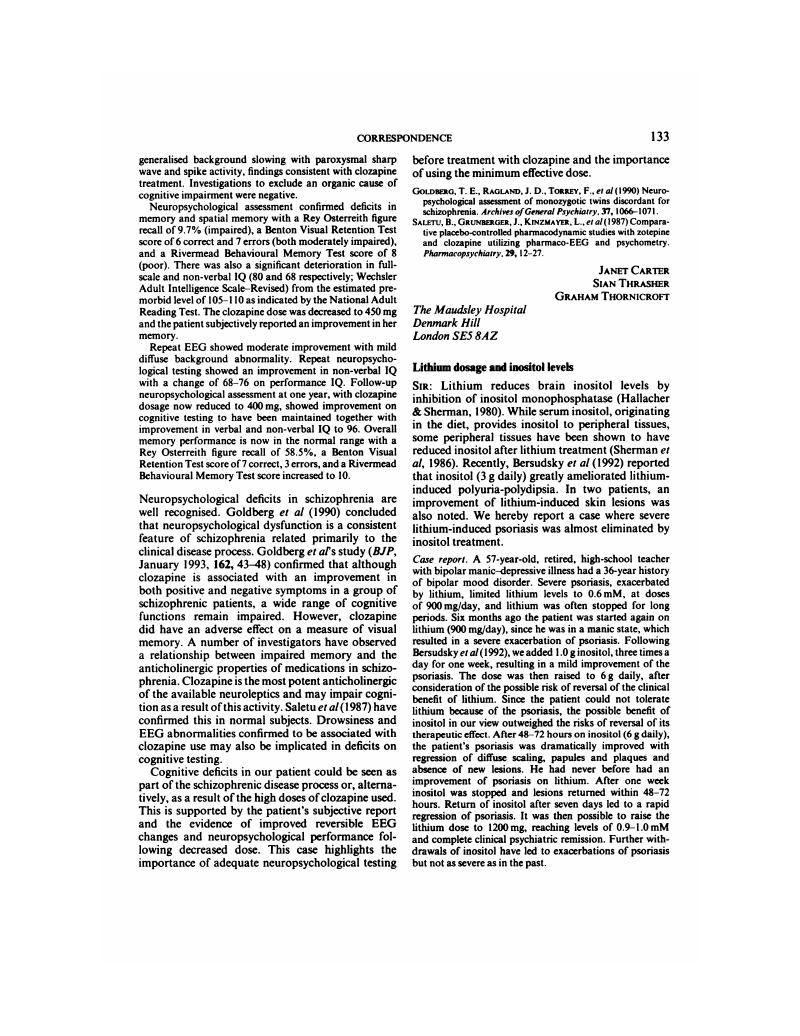Crossref Citations
This article has been cited by the following publications. This list is generated based on data provided by Crossref.
Schou, Mogens
1994.
Vol. 18,
Issue. ,
p.
25.
&NA;
1994.
Lithium.
Reactions Weekly,
Vol. &NA;,
Issue. 500,
p.
9.
Botteron, Kelly N.
and
Geller, Barbara
1995.
Pharmacologic Treatment of Childhood and Adolescent Mania.
Child and Adolescent Psychiatric Clinics of North America,
Vol. 4,
Issue. 2,
p.
283.
Belmaker, M.D, R. H.
Bersudsky, M.D, Yuly
Agam, M.D, Galila
Levine, M.D, Joseph
and
Kofman, M.D, Ora
1996.
HOW DOES LITHIUM WORK ON MANIC DEPRESSION? Clinical and Psychological Correlates of the Inositol Theory.
Annual Review of Medicine,
Vol. 47,
Issue. 1,
p.
47.
Levine, J.
Shectman, T.
Lefkifker, E.
Horesh, N.
Shapiro, J.
Agam, G.
and
Bersudsky, Y.
1997.
Inositol may reverse lithium-induced polydipsia but not polyuria.
Human Psychopharmacology: Clinical and Experimental,
Vol. 12,
Issue. 5,
p.
459.
Allan, S.J.R.
Kavanagh, G.M.
Herd, R.M.
and
Savin, J.A.
2004.
The effect of inositol supplements on the psoriasis of patients taking lithium: a randomized, placebo-controlled trial.
British Journal of Dermatology,
Vol. 150,
Issue. 5,
p.
966.
Jafferany, Mohammad
2008.
Lithium and skin: dermatologic manifestations of lithium therapy.
International Journal of Dermatology,
Vol. 47,
Issue. 11,
p.
1101.
Basavaraj, Kabbur Hanumanthappa
Ashok, Navya Mysore
Rashmi, Ramesh
and
Praveen, Thaggikuppe Krishnamurthy
2010.
The role of drugs in the induction and/or exacerbation of psoriasis.
International Journal of Dermatology,
Vol. 49,
Issue. 12,
p.
1351.
Kontoangelos, Konstantinos
Vaidakis, Nikolaos
Zervas, Ioannis
Thomadaki, Olga
Christaki, Smaragda
Stavrianeas, Nikolaos G
and
Papadimitriou, George N
2010.
Administration of inositol to a patient with bipolar disorder and psoriasis: a case report.
Cases Journal,
Vol. 3,
Issue. 1,
Peng, Dailiang
Zhang, Helin
Liu, Liangyun
Huang, Wenjiang
Huete, Alfredo R.
Zhang, Xiaoyang
Wang, Fumin
Yu, Le
Xie, Qiaoyun
Wang, Cheng
Luo, Shezhou
Li, Cunjun
and
Zhang, Bing
2019.
Estimating the Aboveground Biomass for Planted Forests Based on Stand Age and Environmental Variables.
Remote Sensing,
Vol. 11,
Issue. 19,
p.
2270.
HIKI, Kojiro
HAYASHI, Hiroaki
and
AOYAMA, Yumi
2021.
Lithium Associated Psoriasis Successfully Treated with Apremilast.
Nishi Nihon Hifuka,
Vol. 83,
Issue. 1,
p.
26.






eLetters
No eLetters have been published for this article.